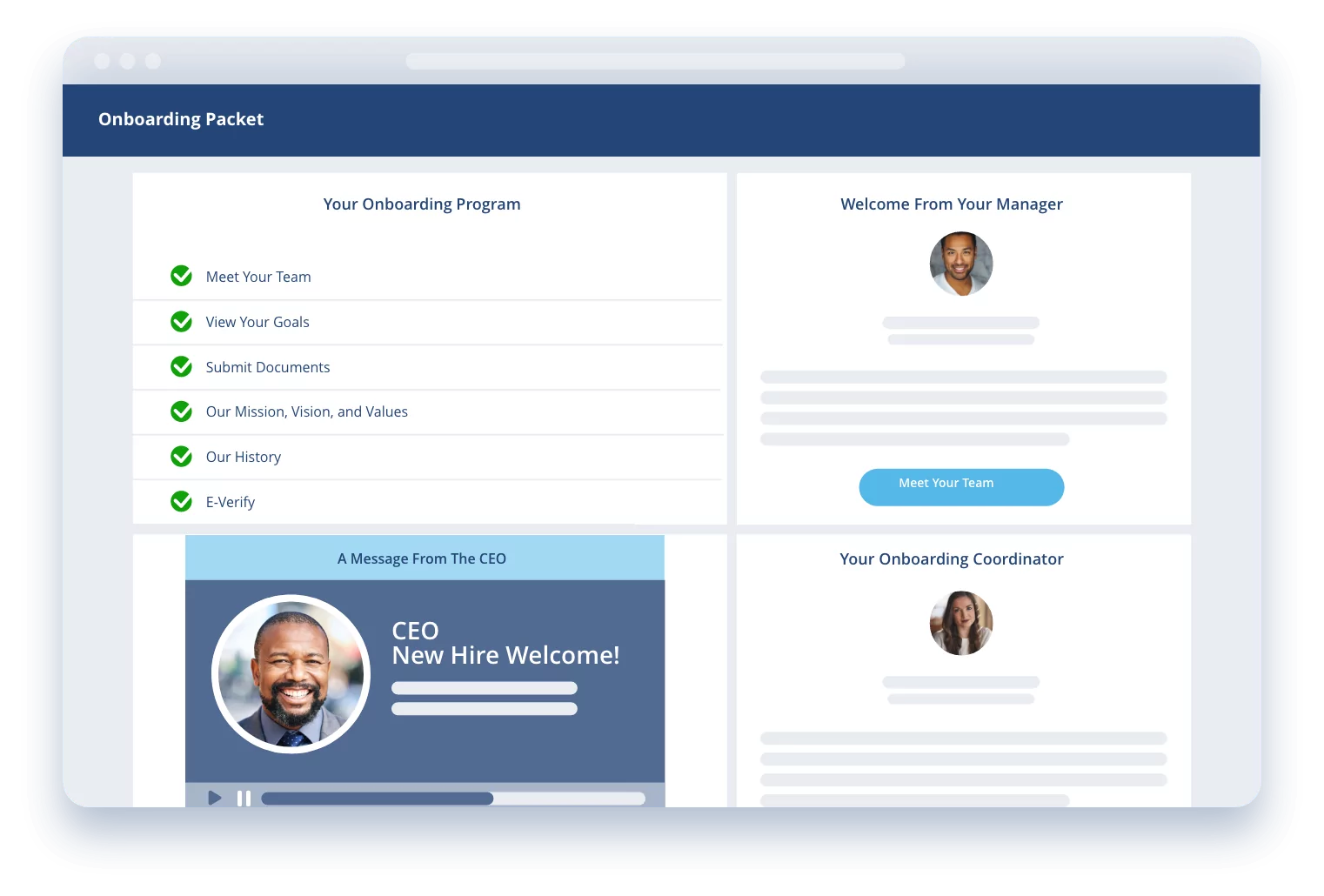This post was first published in January 2021.
It was updated with new content and information in September 2023.
Organizations thrive when employees thrive, and employees thrive when they feel connected to company culture and equipped to perform at their best. You can establish your culture through what you share in your job descriptions, on your career site, and during candidate screening calls. You equip them with the right tools during their first few days on the job. But still, your new employees are quitting all too often, and it’s driving up hiring costs.
If that sounds familiar, your human resources team needs a more effective onboarding program. A good onboarding process requires time, resources, and buy-in from leadership to support spending said time and resources on developing your process. To get the go-ahead on developing a better strategy and the budget you need for onboarding tools, you’ll need to prove the return on investment (ROI) of an effective onboarding strategy.
Below, we discuss why an effective onboarding strategy matters, what you gain from a strong process, and share the secret for taking your onboarding process to the next level.
Invest in your employees from day one with an effective onboarding program.The ROI of this strategy speaks for itself:
What is New Employee Turnover Costing You?
While every organization onboards new employees to some degree, many lack the impactful experience employees crave. In fact, 88% of all employees believe their company doesn’t provide a positive or effective onboarding process. That comes with steep costs:
-
New hire retention rates suffer, with about 20% quitting in the first 45 days.
-
33% of employees say they’d quit if they had a bad onboarding experience.
-
Replacing an employee costs as much as 40% of their salary.
-
Poor onboarding leads to disengagement, which costs businesses nearly $9 trillion in lost productivity worldwide.
You can avoid the high costs of new hire turnover with an onboarding process that makes employees feel prepared, welcome, and aligned with the company.
What Makes an Effective Onboarding Strategy?
Organizations can (and should) take advantage of the onboarding process to ensure that employees experience a smooth transition into their new role and feel welcomed into your team. But one-third of companies don’t have an onboarding process at all. And, we can tell from the statistics that a majority of new hires aren’t happy with the current state of onboarding:
-
52% of new hires say they feel undertrained.
-
32% of new hires find onboarding to be confusing, while 22% say it’s disorganized.
-
Only 29% of new hires feel prepared to excel in their new role.
-
32% of new hires who quit early say it was due to company culture that didn’t match their expectations.
Fortunately, those numbers also tell you exactly what it takes to create a positive onboarding experience that sets new hires up for success.
An effective onboarding strategy is one that puts company culture at the forefront. Your new hires shouldn’t have to wonder about how to ask questions, how meetings are run, or how employees collaborate. Those are just a few of the factors that impact your company culture, and you should address as many as possible during onboarding and give employees plenty of time to ask clarifying questions, too.
Your onboarding strategy needs to prepare employees for their new jobs. That should go without saying, but it’s clear from the data that many new hires don’t feel their onboarding process gave them the tools they need to do well. Effective onboarding includes check-ins and simple performance reviews to keep new hires on track. Onboarding should also be structured and organized, mitigating confusion among your new hires and making it easier for hiring managers to prepare for an employee’s first day.

Outstanding Onboarding by the Numbers
In addition to fostering a strong and supportive culture in your organization, an effective onboarding strategy also has quantifiable benefits for your company. As a general rule of thumb, the more effective your onboarding strategy is, the faster your new hires can become productive members of your organization. With a robust, repeatable onboarding process, you can equip your employees with the tools they need to execute their job duties and ensure all team members have what they need to perform at their best.
Here’s what you’ll get from an effective onboarding process.
1. Better Employee Retention (Not Just Among New Hires)
It takes 90% of new hires around six months to decide if they want to stay at their new jobs. Increase the chances that they’ll stay with a formal onboarding process: some companies have seen retention increase by as much as 50% when they started their own.
An excellent onboarding experience has a ripple effect —69% of employees will still be at your company three years later if they say their onboarding experience was a good one.
2. Reduced Time to Productivity
Time-to-productivity refers to the length of time it takes employees to reach their full performance potential in a new role. According to Gallup research, that’s usually around 12 months —one full year. While it doesn’t need to last 12 months, the average length of a good onboarding program is 90 days.
Unfortunately, lots of employees don’t get more than one full day of onboarding, with 43% saying their “onboarding program” was comprised of just one day of orientation (which isn’t the same thing) and a welcome packet. That’s no doubt why many say they feel unprepared after onboarding.
You can help employees reach full productivity faster when you set performance goals in the onboarding process. That helps managers quickly see if employees are on track to be ready to take on their roles or if they need to adapt onboarding plans to address any challenges. Either way, you can get employees fully ramped far more quickly when you’re following a plan. You’re also likely to see increased productivity, with companies reporting up to 62% higher productivity with an onboarding plan.
3. Increased Engagement
Onboarding is your chance to capture new employees’ enthusiasm by setting expectations and establishing strong connections that keep them interested in their work and loyal to your company. Great onboarding can lead to a 54% increase in engagement.
4. Improved Company Culture
How you manage the employee lifecycle impacts your culture, and onboarding is a foundational part of that lifecycle. As such, it’s not too bold to claim that onboarding is part of the very foundation of company culture. Culture is often a factor in why employees accept job offers, and onboarding is when you can reinforce what they already know and love about it.
5. ROI That Grows
Investing in an onboarding system isn’t an insignificant business cost, but that’s because it generates ROI indefinitely. An onboarding system won’t have high returns the first year that then start to drop off. If you’re using it wisely, you can expect to see ROI climb year after year due to many factors:
-
Better employee retention over a sustained period leads to lower hiring costs and an invaluable depth of knowledge among your workforce.
-
Engaging employees from their first day helps maintain motivation, leading to increased innovation.
-
Employees who have excellent onboarding experiences talk about them, becoming brand ambassadors whose endorsements attract more top talent to your organization.
Software That Takes Onboarding to the Next Level
Today, many employees are rarely in the office —or you might not have a central office at all. They’re working remotely, on hybrid schedules, or out in the field. Even if your workforce is entirely in-person, employees are on the go. The paper-based manual onboarding processes of the past are tedious and ineffective, and they can’t keep up.
Ditch the mountain of new hire paperwork and increase your onboarding ROI online onboarding software. Completely paperless digital onboarding streamlines tedious work that used to take hours for HR teams to complete. With a new onboarding system, your team can:
-
Upload documents to new hire portals where they can electronically sign and submit paperwork before their start date.
-
Build welcome packets for each role so every new hire gets the information they need and fills out the right forms (digitally, of course).
-
Automate task notifications so new hires and hiring managers complete onboarding tasks in a timely manner.
-
Complete background checks and employment verifications within the system for seamless compliance.
-
Keep new hires on track with their onboarding plan.
ClearCompany’s Onboarding platform offers seamless integration with our ATS and talent management platforms. HR professionals can effortlessly move people from the hiring process into onboarding. Interactive dashboards and a user-friendly interface make adoption easy for your HR team, new employees, and hiring managers.
To learn more about how ClearCompany can help your organization digitize its processes, implement an effective onboarding strategy, and maximize onboarding ROI, speak to an expert or sign up for your free demo today.


